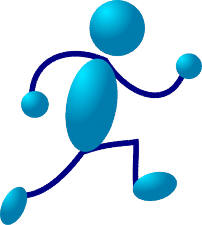
Fitness Topics: Can I Spot-Reduce to Lose Weight in a Specific Area, Such as My "Love Handles"?
Unfortunately, our bodies don't distinguish between those
muscles that are exercised, and the areas from which fat is burn. The body backs
on fat according to your genetics and takes it off similarly. In other words,
you may be prone to packing on the pounds on your thighs, but exercising your
thighs won't cause the weight to come off from there first.
Rather, it is a simple mass balance. Each pound of fat is roughly 3500 calories
(kilocalories, actually, but most people just call them "calories"). If you
consume 2000 calories in one day (which is quite a bit more than most men or
women need) and your basal metabolism is 1000 calories per day and you lift
weights of an intensity and duration that consumes 500 calories... Then you
would still GAIN one pound every 7 days :
2000 minus 1000 minus 500 = 500 extra calories every day, and 7 day times 500
equals 3500 or 1 pound of fat.
So, in this case it may take weight lifting AND some dietary restraint to
actually lose weight. If you were to consume 1200 calories per day, with a basal
metabolism of 1000 calories and 500 calories of exercise every day, then you
would burn off 300 calories per day, and approximately every 12 days, you'd LOSE
a pound of fat.
Now, back to where that fat would come off... Probably according to the
distribution on your body. If most of your fat is in your backside (if the label
on your jeans is "Lardass" instead of "Jordache" that might be a clue...:) then
fat loss would probably be most noticeable there. In other words, it generally
comes off the same way it went on.
Spot reducing is only possible through liposuction. And generally speaking,
exercising specific muscles because there is more fat near them may also be
counter-productive, unless those muscles happen to be the largest muscles. You
see, the calories burned are equal to a simple formula from
Isaac Newton,
that is, basic physics. Work (total energy burned) = the amount of force
exerted times the mass (weight) moved against resistance (usually gravity) times
the distance it is moved and times the number of times you repeat the action.
Energy consumed = Force x Mass x Distance x Repetitions. So obviously, the
larger the force exerted, and the larger the weight lifted, the more energy you
burn and the more fat you lose. And larger muscles can lift heavier weights than
smaller muscles. So squats (which work the quadriceps and gluts (butt)), bench
presses (which work the chest), and rowing (which works the back) burn more
energy than arm curls, calf exercises or abdominal exercises.
However, toning up the muscles of a given area, such as the abdomen, can pull it
in some and make it appear slimmer, sooner.
Summary:
So the short answer is: there is no such thing as "spot reducing", but it doing extra exercises in that area may help make it look firmer, even before you've lost the fat there. But be sure to spend most of your workout lifting weights with the large muscles of the legs, back and chest, before you worry about forearms, shoulders, abs and the like!
Footnotes:
The calorie is defined as the amount of heat required to change the temperature of one gram of water by one degree Celsius. A kilocalorie is 1000 calories. The kilocalorie is what most people refer to as a "calorie".